Analysis of the Unequal Distribution of Globalization's Effects
VerifiedAdded on 2020/04/15
|11
|2679
|40
Report
AI Summary
This report delves into the multifaceted effects of globalization, emphasizing its unequal distribution across the globe. It begins by defining globalization and highlighting its significance, setting the stage for an analysis of its economic, cultural, and political dimensions. The report explores both the benefits, such as increased trade and market expansion, and the problems, including intense competition and income inequality. It examines the impact of globalization on developed, developing, and transitional economies, explaining the reasons behind the differing experiences. The report references the APEC summit to illustrate real-world examples of globalization's impact and concludes by summarizing the complex interplay of factors that determine how globalization shapes the world's economies.
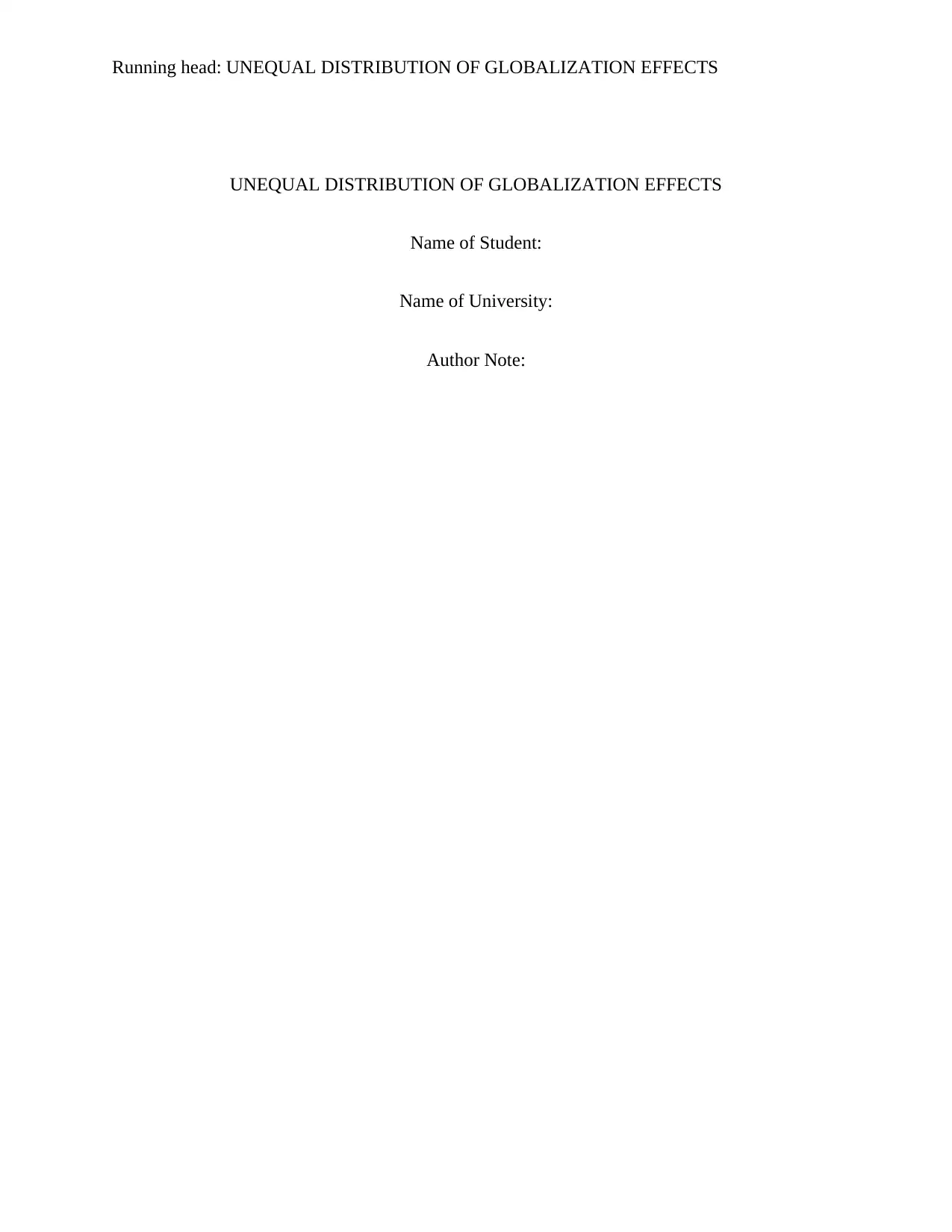
Running head: UNEQUAL DISTRIBUTION OF GLOBALIZATION EFFECTS
UNEQUAL DISTRIBUTION OF GLOBALIZATION EFFECTS
Name of Student:
Name of University:
Author Note:
UNEQUAL DISTRIBUTION OF GLOBALIZATION EFFECTS
Name of Student:
Name of University:
Author Note:
Paraphrase This Document
Need a fresh take? Get an instant paraphrase of this document with our AI Paraphraser
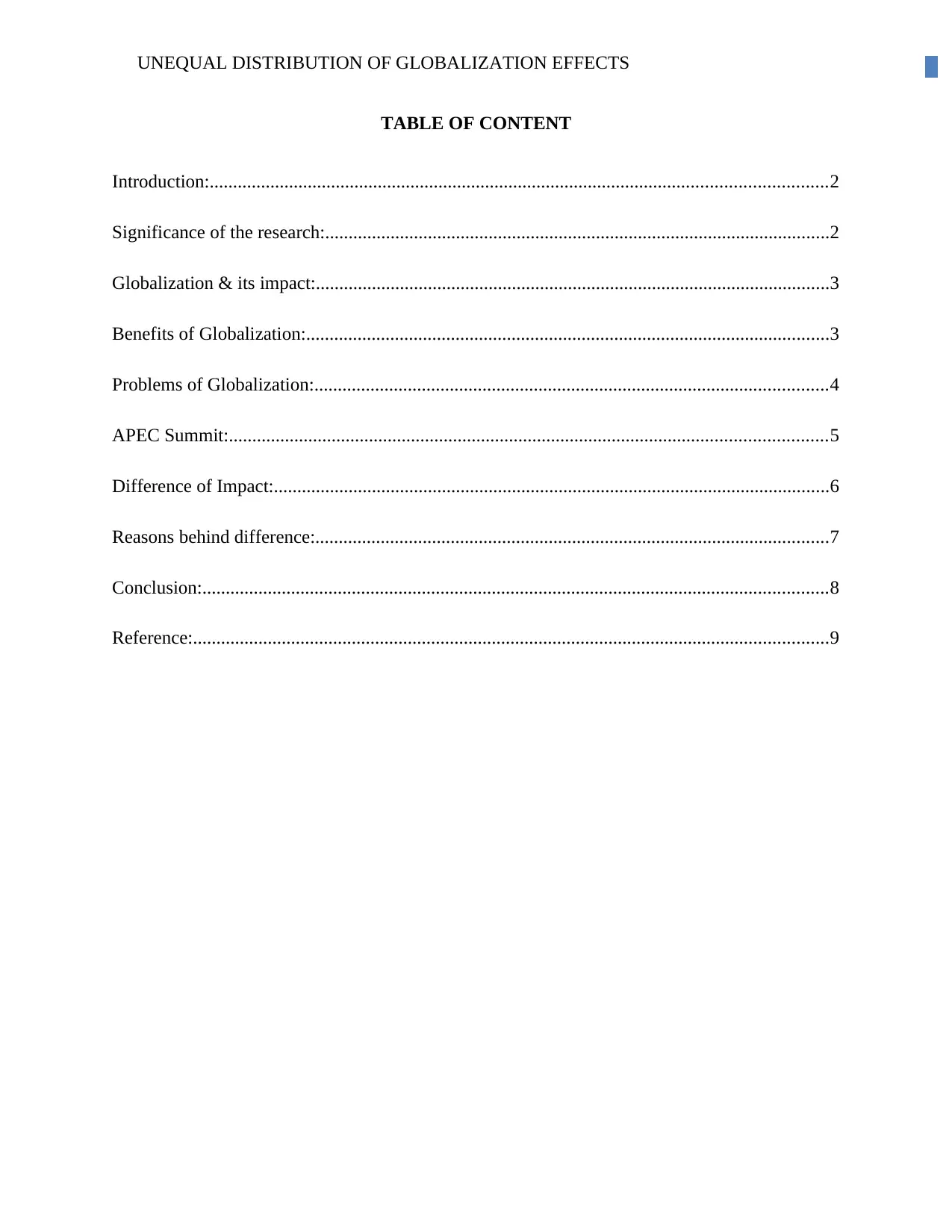
1UNEQUAL DISTRIBUTION OF GLOBALIZATION EFFECTS
TABLE OF CONTENT
Introduction:....................................................................................................................................2
Significance of the research:............................................................................................................2
Globalization & its impact:..............................................................................................................3
Benefits of Globalization:................................................................................................................3
Problems of Globalization:..............................................................................................................4
APEC Summit:................................................................................................................................5
Difference of Impact:.......................................................................................................................6
Reasons behind difference:..............................................................................................................7
Conclusion:......................................................................................................................................8
Reference:........................................................................................................................................9
TABLE OF CONTENT
Introduction:....................................................................................................................................2
Significance of the research:............................................................................................................2
Globalization & its impact:..............................................................................................................3
Benefits of Globalization:................................................................................................................3
Problems of Globalization:..............................................................................................................4
APEC Summit:................................................................................................................................5
Difference of Impact:.......................................................................................................................6
Reasons behind difference:..............................................................................................................7
Conclusion:......................................................................................................................................8
Reference:........................................................................................................................................9
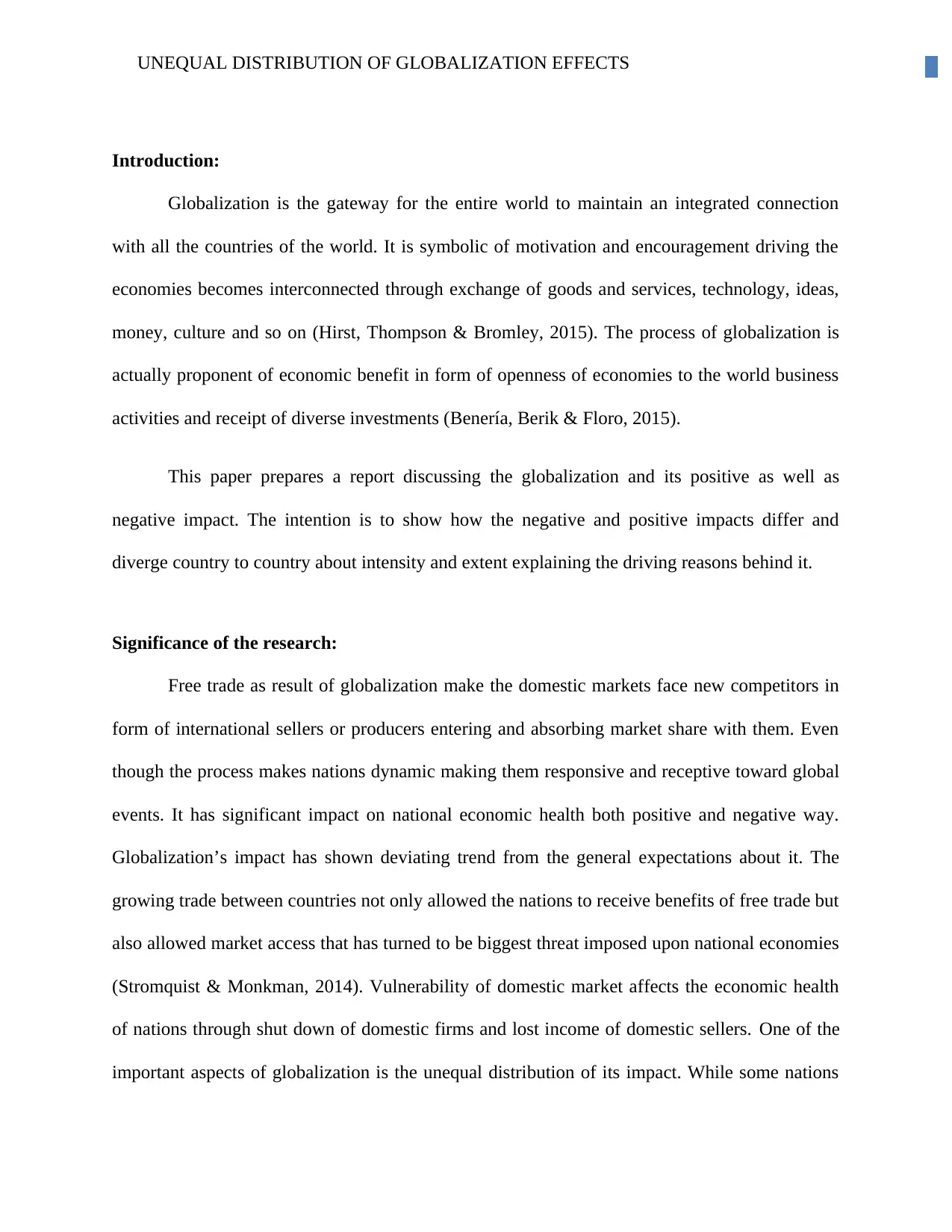
2UNEQUAL DISTRIBUTION OF GLOBALIZATION EFFECTS
Introduction:
Globalization is the gateway for the entire world to maintain an integrated connection
with all the countries of the world. It is symbolic of motivation and encouragement driving the
economies becomes interconnected through exchange of goods and services, technology, ideas,
money, culture and so on (Hirst, Thompson & Bromley, 2015). The process of globalization is
actually proponent of economic benefit in form of openness of economies to the world business
activities and receipt of diverse investments (Benería, Berik & Floro, 2015).
This paper prepares a report discussing the globalization and its positive as well as
negative impact. The intention is to show how the negative and positive impacts differ and
diverge country to country about intensity and extent explaining the driving reasons behind it.
Significance of the research:
Free trade as result of globalization make the domestic markets face new competitors in
form of international sellers or producers entering and absorbing market share with them. Even
though the process makes nations dynamic making them responsive and receptive toward global
events. It has significant impact on national economic health both positive and negative way.
Globalization’s impact has shown deviating trend from the general expectations about it. The
growing trade between countries not only allowed the nations to receive benefits of free trade but
also allowed market access that has turned to be biggest threat imposed upon national economies
(Stromquist & Monkman, 2014). Vulnerability of domestic market affects the economic health
of nations through shut down of domestic firms and lost income of domestic sellers. One of the
important aspects of globalization is the unequal distribution of its impact. While some nations
Introduction:
Globalization is the gateway for the entire world to maintain an integrated connection
with all the countries of the world. It is symbolic of motivation and encouragement driving the
economies becomes interconnected through exchange of goods and services, technology, ideas,
money, culture and so on (Hirst, Thompson & Bromley, 2015). The process of globalization is
actually proponent of economic benefit in form of openness of economies to the world business
activities and receipt of diverse investments (Benería, Berik & Floro, 2015).
This paper prepares a report discussing the globalization and its positive as well as
negative impact. The intention is to show how the negative and positive impacts differ and
diverge country to country about intensity and extent explaining the driving reasons behind it.
Significance of the research:
Free trade as result of globalization make the domestic markets face new competitors in
form of international sellers or producers entering and absorbing market share with them. Even
though the process makes nations dynamic making them responsive and receptive toward global
events. It has significant impact on national economic health both positive and negative way.
Globalization’s impact has shown deviating trend from the general expectations about it. The
growing trade between countries not only allowed the nations to receive benefits of free trade but
also allowed market access that has turned to be biggest threat imposed upon national economies
(Stromquist & Monkman, 2014). Vulnerability of domestic market affects the economic health
of nations through shut down of domestic firms and lost income of domestic sellers. One of the
important aspects of globalization is the unequal distribution of its impact. While some nations
⊘ This is a preview!⊘
Do you want full access?
Subscribe today to unlock all pages.

Trusted by 1+ million students worldwide
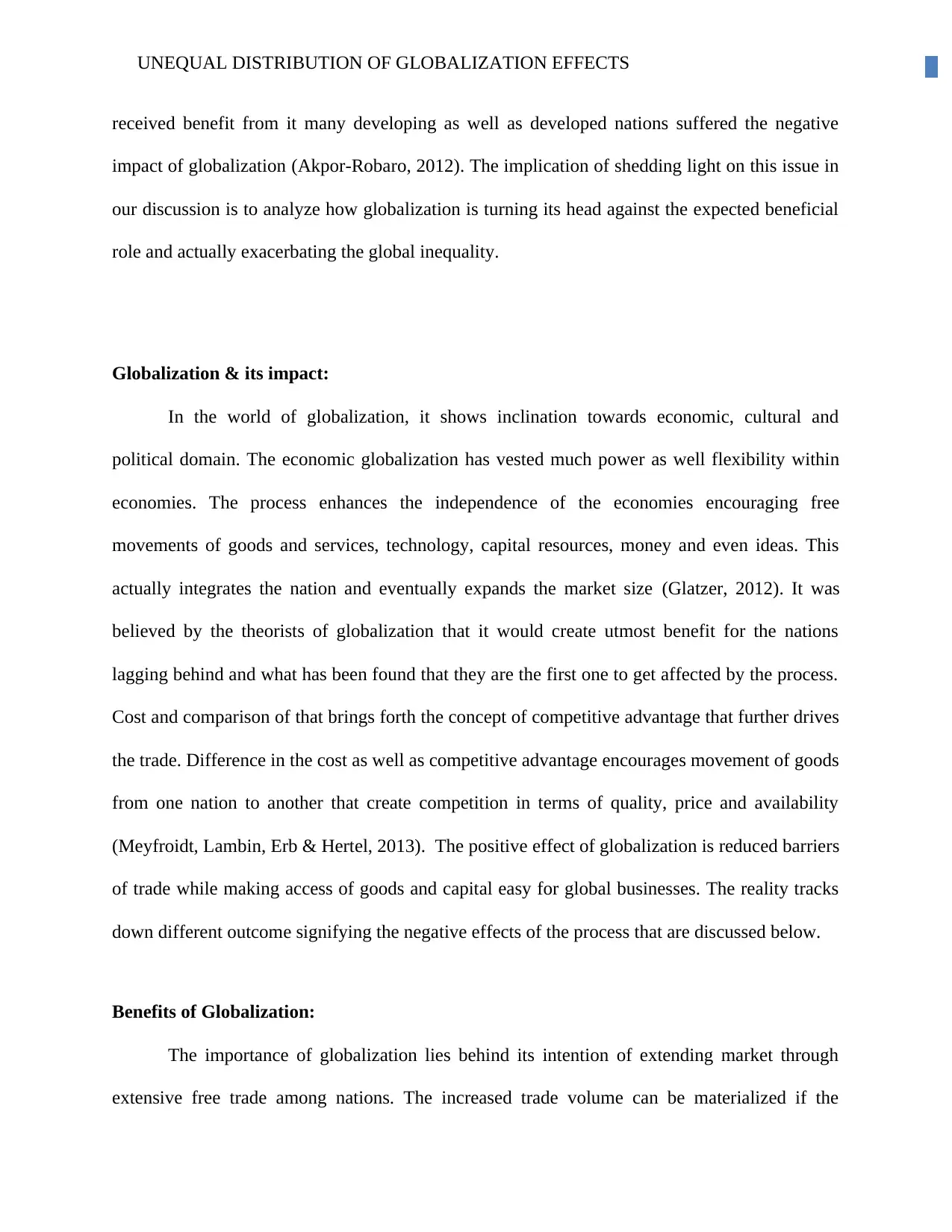
3UNEQUAL DISTRIBUTION OF GLOBALIZATION EFFECTS
received benefit from it many developing as well as developed nations suffered the negative
impact of globalization (Akpor-Robaro, 2012). The implication of shedding light on this issue in
our discussion is to analyze how globalization is turning its head against the expected beneficial
role and actually exacerbating the global inequality.
Globalization & its impact:
In the world of globalization, it shows inclination towards economic, cultural and
political domain. The economic globalization has vested much power as well flexibility within
economies. The process enhances the independence of the economies encouraging free
movements of goods and services, technology, capital resources, money and even ideas. This
actually integrates the nation and eventually expands the market size (Glatzer, 2012). It was
believed by the theorists of globalization that it would create utmost benefit for the nations
lagging behind and what has been found that they are the first one to get affected by the process.
Cost and comparison of that brings forth the concept of competitive advantage that further drives
the trade. Difference in the cost as well as competitive advantage encourages movement of goods
from one nation to another that create competition in terms of quality, price and availability
(Meyfroidt, Lambin, Erb & Hertel, 2013). The positive effect of globalization is reduced barriers
of trade while making access of goods and capital easy for global businesses. The reality tracks
down different outcome signifying the negative effects of the process that are discussed below.
Benefits of Globalization:
The importance of globalization lies behind its intention of extending market through
extensive free trade among nations. The increased trade volume can be materialized if the
received benefit from it many developing as well as developed nations suffered the negative
impact of globalization (Akpor-Robaro, 2012). The implication of shedding light on this issue in
our discussion is to analyze how globalization is turning its head against the expected beneficial
role and actually exacerbating the global inequality.
Globalization & its impact:
In the world of globalization, it shows inclination towards economic, cultural and
political domain. The economic globalization has vested much power as well flexibility within
economies. The process enhances the independence of the economies encouraging free
movements of goods and services, technology, capital resources, money and even ideas. This
actually integrates the nation and eventually expands the market size (Glatzer, 2012). It was
believed by the theorists of globalization that it would create utmost benefit for the nations
lagging behind and what has been found that they are the first one to get affected by the process.
Cost and comparison of that brings forth the concept of competitive advantage that further drives
the trade. Difference in the cost as well as competitive advantage encourages movement of goods
from one nation to another that create competition in terms of quality, price and availability
(Meyfroidt, Lambin, Erb & Hertel, 2013). The positive effect of globalization is reduced barriers
of trade while making access of goods and capital easy for global businesses. The reality tracks
down different outcome signifying the negative effects of the process that are discussed below.
Benefits of Globalization:
The importance of globalization lies behind its intention of extending market through
extensive free trade among nations. The increased trade volume can be materialized if the
Paraphrase This Document
Need a fresh take? Get an instant paraphrase of this document with our AI Paraphraser
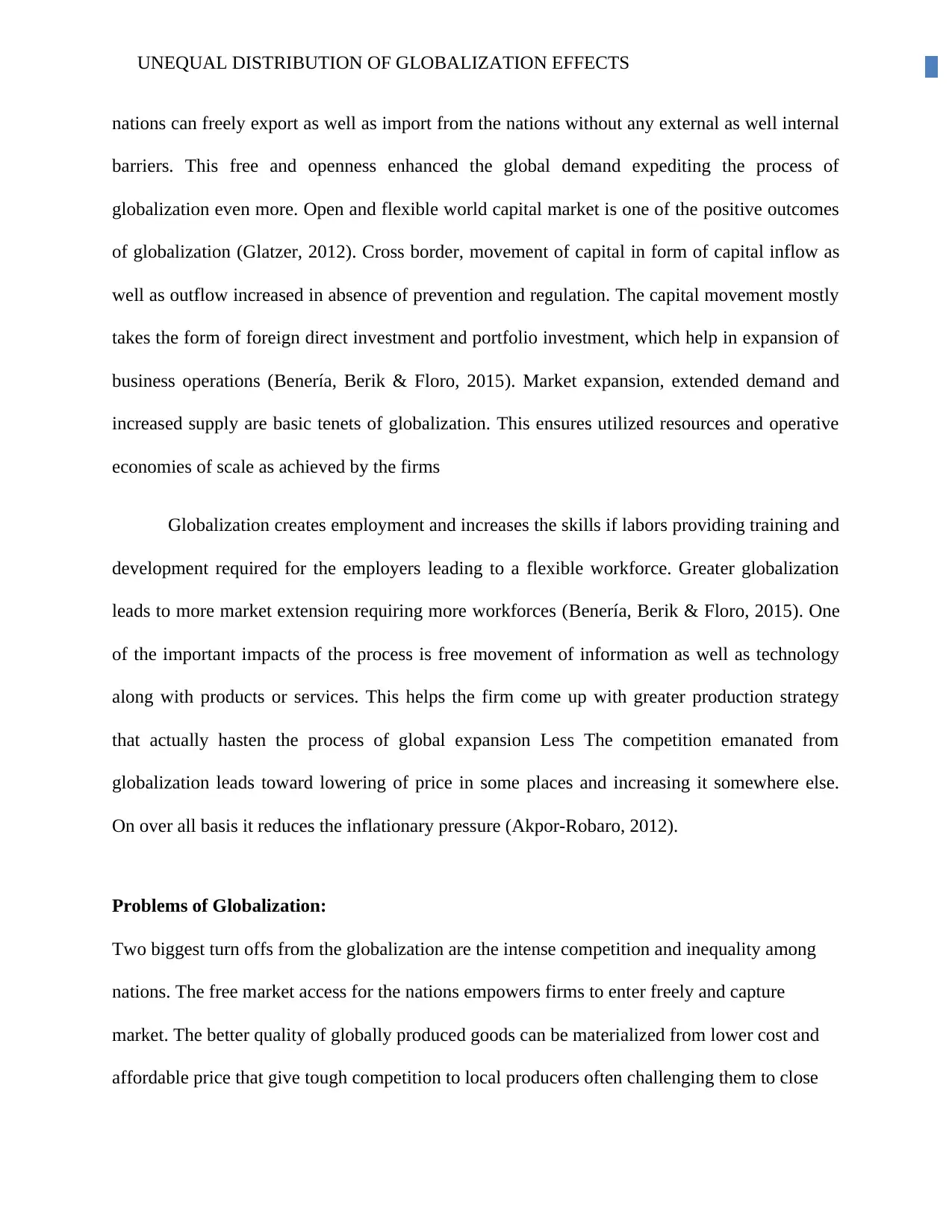
4UNEQUAL DISTRIBUTION OF GLOBALIZATION EFFECTS
nations can freely export as well as import from the nations without any external as well internal
barriers. This free and openness enhanced the global demand expediting the process of
globalization even more. Open and flexible world capital market is one of the positive outcomes
of globalization (Glatzer, 2012). Cross border, movement of capital in form of capital inflow as
well as outflow increased in absence of prevention and regulation. The capital movement mostly
takes the form of foreign direct investment and portfolio investment, which help in expansion of
business operations (Benería, Berik & Floro, 2015). Market expansion, extended demand and
increased supply are basic tenets of globalization. This ensures utilized resources and operative
economies of scale as achieved by the firms
Globalization creates employment and increases the skills if labors providing training and
development required for the employers leading to a flexible workforce. Greater globalization
leads to more market extension requiring more workforces (Benería, Berik & Floro, 2015). One
of the important impacts of the process is free movement of information as well as technology
along with products or services. This helps the firm come up with greater production strategy
that actually hasten the process of global expansion Less The competition emanated from
globalization leads toward lowering of price in some places and increasing it somewhere else.
On over all basis it reduces the inflationary pressure (Akpor-Robaro, 2012).
Problems of Globalization:
Two biggest turn offs from the globalization are the intense competition and inequality among
nations. The free market access for the nations empowers firms to enter freely and capture
market. The better quality of globally produced goods can be materialized from lower cost and
affordable price that give tough competition to local producers often challenging them to close
nations can freely export as well as import from the nations without any external as well internal
barriers. This free and openness enhanced the global demand expediting the process of
globalization even more. Open and flexible world capital market is one of the positive outcomes
of globalization (Glatzer, 2012). Cross border, movement of capital in form of capital inflow as
well as outflow increased in absence of prevention and regulation. The capital movement mostly
takes the form of foreign direct investment and portfolio investment, which help in expansion of
business operations (Benería, Berik & Floro, 2015). Market expansion, extended demand and
increased supply are basic tenets of globalization. This ensures utilized resources and operative
economies of scale as achieved by the firms
Globalization creates employment and increases the skills if labors providing training and
development required for the employers leading to a flexible workforce. Greater globalization
leads to more market extension requiring more workforces (Benería, Berik & Floro, 2015). One
of the important impacts of the process is free movement of information as well as technology
along with products or services. This helps the firm come up with greater production strategy
that actually hasten the process of global expansion Less The competition emanated from
globalization leads toward lowering of price in some places and increasing it somewhere else.
On over all basis it reduces the inflationary pressure (Akpor-Robaro, 2012).
Problems of Globalization:
Two biggest turn offs from the globalization are the intense competition and inequality among
nations. The free market access for the nations empowers firms to enter freely and capture
market. The better quality of globally produced goods can be materialized from lower cost and
affordable price that give tough competition to local producers often challenging them to close
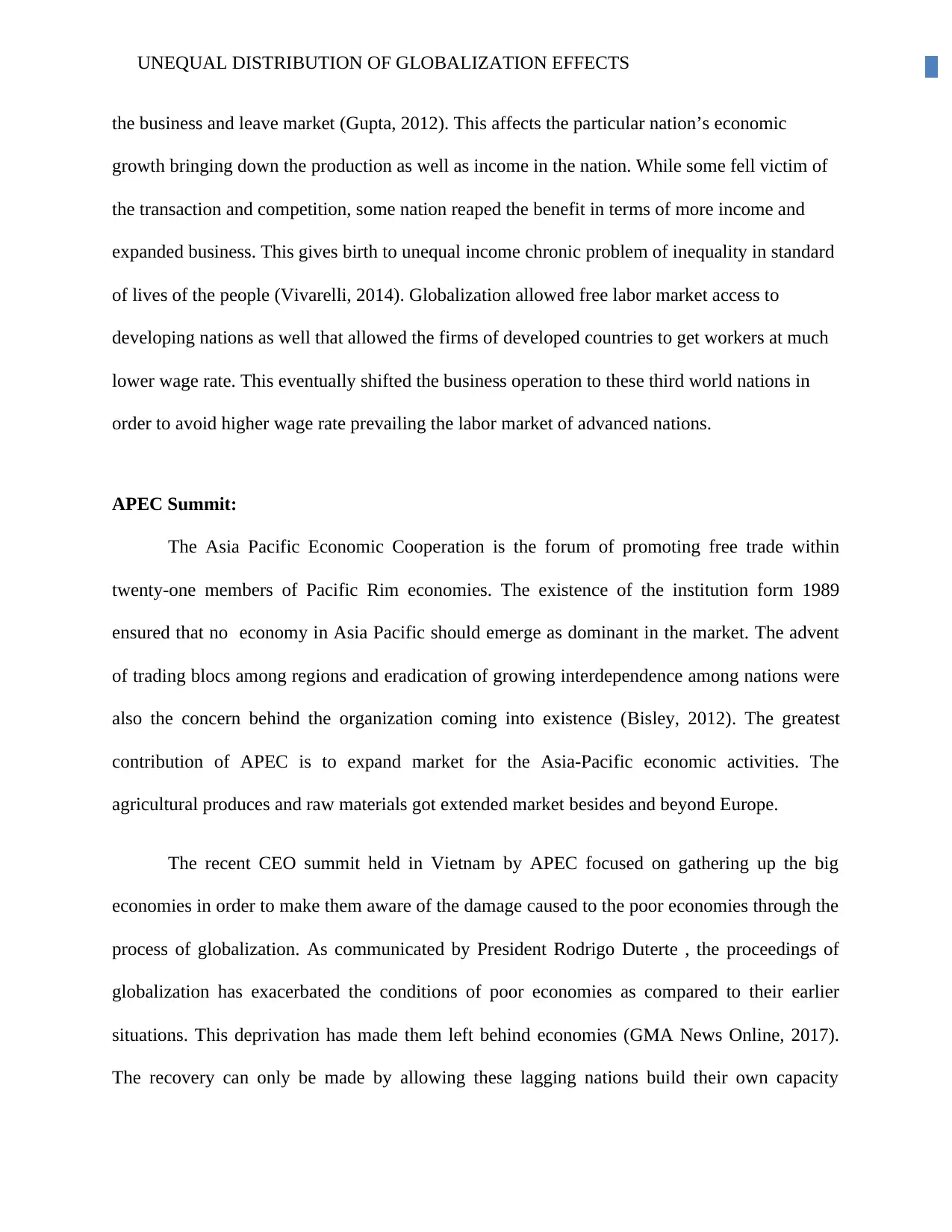
5UNEQUAL DISTRIBUTION OF GLOBALIZATION EFFECTS
the business and leave market (Gupta, 2012). This affects the particular nation’s economic
growth bringing down the production as well as income in the nation. While some fell victim of
the transaction and competition, some nation reaped the benefit in terms of more income and
expanded business. This gives birth to unequal income chronic problem of inequality in standard
of lives of the people (Vivarelli, 2014). Globalization allowed free labor market access to
developing nations as well that allowed the firms of developed countries to get workers at much
lower wage rate. This eventually shifted the business operation to these third world nations in
order to avoid higher wage rate prevailing the labor market of advanced nations.
APEC Summit:
The Asia Pacific Economic Cooperation is the forum of promoting free trade within
twenty-one members of Pacific Rim economies. The existence of the institution form 1989
ensured that no economy in Asia Pacific should emerge as dominant in the market. The advent
of trading blocs among regions and eradication of growing interdependence among nations were
also the concern behind the organization coming into existence (Bisley, 2012). The greatest
contribution of APEC is to expand market for the Asia-Pacific economic activities. The
agricultural produces and raw materials got extended market besides and beyond Europe.
The recent CEO summit held in Vietnam by APEC focused on gathering up the big
economies in order to make them aware of the damage caused to the poor economies through the
process of globalization. As communicated by President Rodrigo Duterte , the proceedings of
globalization has exacerbated the conditions of poor economies as compared to their earlier
situations. This deprivation has made them left behind economies (GMA News Online, 2017).
The recovery can only be made by allowing these lagging nations build their own capacity
the business and leave market (Gupta, 2012). This affects the particular nation’s economic
growth bringing down the production as well as income in the nation. While some fell victim of
the transaction and competition, some nation reaped the benefit in terms of more income and
expanded business. This gives birth to unequal income chronic problem of inequality in standard
of lives of the people (Vivarelli, 2014). Globalization allowed free labor market access to
developing nations as well that allowed the firms of developed countries to get workers at much
lower wage rate. This eventually shifted the business operation to these third world nations in
order to avoid higher wage rate prevailing the labor market of advanced nations.
APEC Summit:
The Asia Pacific Economic Cooperation is the forum of promoting free trade within
twenty-one members of Pacific Rim economies. The existence of the institution form 1989
ensured that no economy in Asia Pacific should emerge as dominant in the market. The advent
of trading blocs among regions and eradication of growing interdependence among nations were
also the concern behind the organization coming into existence (Bisley, 2012). The greatest
contribution of APEC is to expand market for the Asia-Pacific economic activities. The
agricultural produces and raw materials got extended market besides and beyond Europe.
The recent CEO summit held in Vietnam by APEC focused on gathering up the big
economies in order to make them aware of the damage caused to the poor economies through the
process of globalization. As communicated by President Rodrigo Duterte , the proceedings of
globalization has exacerbated the conditions of poor economies as compared to their earlier
situations. This deprivation has made them left behind economies (GMA News Online, 2017).
The recovery can only be made by allowing these lagging nations build their own capacity
⊘ This is a preview!⊘
Do you want full access?
Subscribe today to unlock all pages.

Trusted by 1+ million students worldwide
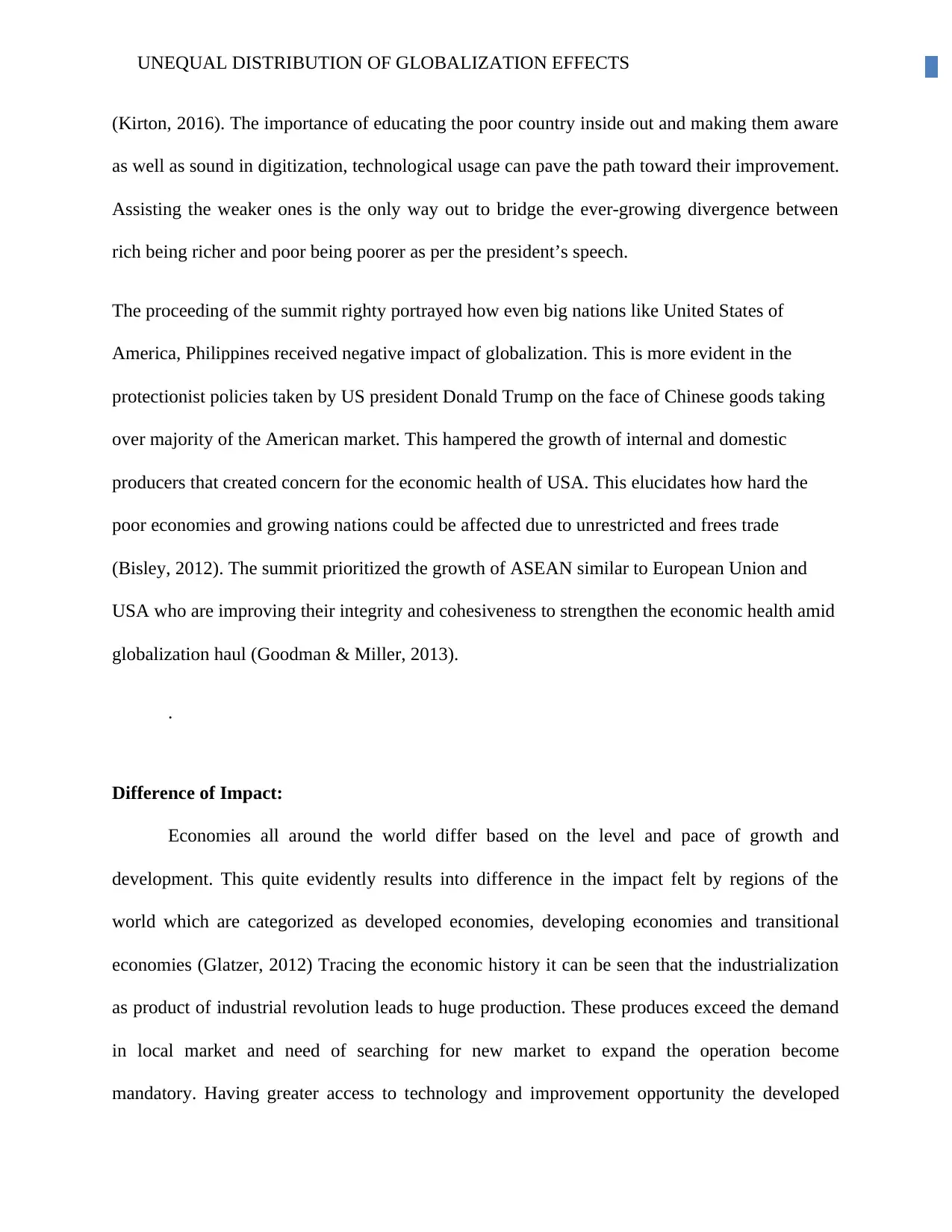
6UNEQUAL DISTRIBUTION OF GLOBALIZATION EFFECTS
(Kirton, 2016). The importance of educating the poor country inside out and making them aware
as well as sound in digitization, technological usage can pave the path toward their improvement.
Assisting the weaker ones is the only way out to bridge the ever-growing divergence between
rich being richer and poor being poorer as per the president’s speech.
The proceeding of the summit righty portrayed how even big nations like United States of
America, Philippines received negative impact of globalization. This is more evident in the
protectionist policies taken by US president Donald Trump on the face of Chinese goods taking
over majority of the American market. This hampered the growth of internal and domestic
producers that created concern for the economic health of USA. This elucidates how hard the
poor economies and growing nations could be affected due to unrestricted and frees trade
(Bisley, 2012). The summit prioritized the growth of ASEAN similar to European Union and
USA who are improving their integrity and cohesiveness to strengthen the economic health amid
globalization haul (Goodman & Miller, 2013).
.
Difference of Impact:
Economies all around the world differ based on the level and pace of growth and
development. This quite evidently results into difference in the impact felt by regions of the
world which are categorized as developed economies, developing economies and transitional
economies (Glatzer, 2012) Tracing the economic history it can be seen that the industrialization
as product of industrial revolution leads to huge production. These produces exceed the demand
in local market and need of searching for new market to expand the operation become
mandatory. Having greater access to technology and improvement opportunity the developed
(Kirton, 2016). The importance of educating the poor country inside out and making them aware
as well as sound in digitization, technological usage can pave the path toward their improvement.
Assisting the weaker ones is the only way out to bridge the ever-growing divergence between
rich being richer and poor being poorer as per the president’s speech.
The proceeding of the summit righty portrayed how even big nations like United States of
America, Philippines received negative impact of globalization. This is more evident in the
protectionist policies taken by US president Donald Trump on the face of Chinese goods taking
over majority of the American market. This hampered the growth of internal and domestic
producers that created concern for the economic health of USA. This elucidates how hard the
poor economies and growing nations could be affected due to unrestricted and frees trade
(Bisley, 2012). The summit prioritized the growth of ASEAN similar to European Union and
USA who are improving their integrity and cohesiveness to strengthen the economic health amid
globalization haul (Goodman & Miller, 2013).
.
Difference of Impact:
Economies all around the world differ based on the level and pace of growth and
development. This quite evidently results into difference in the impact felt by regions of the
world which are categorized as developed economies, developing economies and transitional
economies (Glatzer, 2012) Tracing the economic history it can be seen that the industrialization
as product of industrial revolution leads to huge production. These produces exceed the demand
in local market and need of searching for new market to expand the operation become
mandatory. Having greater access to technology and improvement opportunity the developed
Paraphrase This Document
Need a fresh take? Get an instant paraphrase of this document with our AI Paraphraser
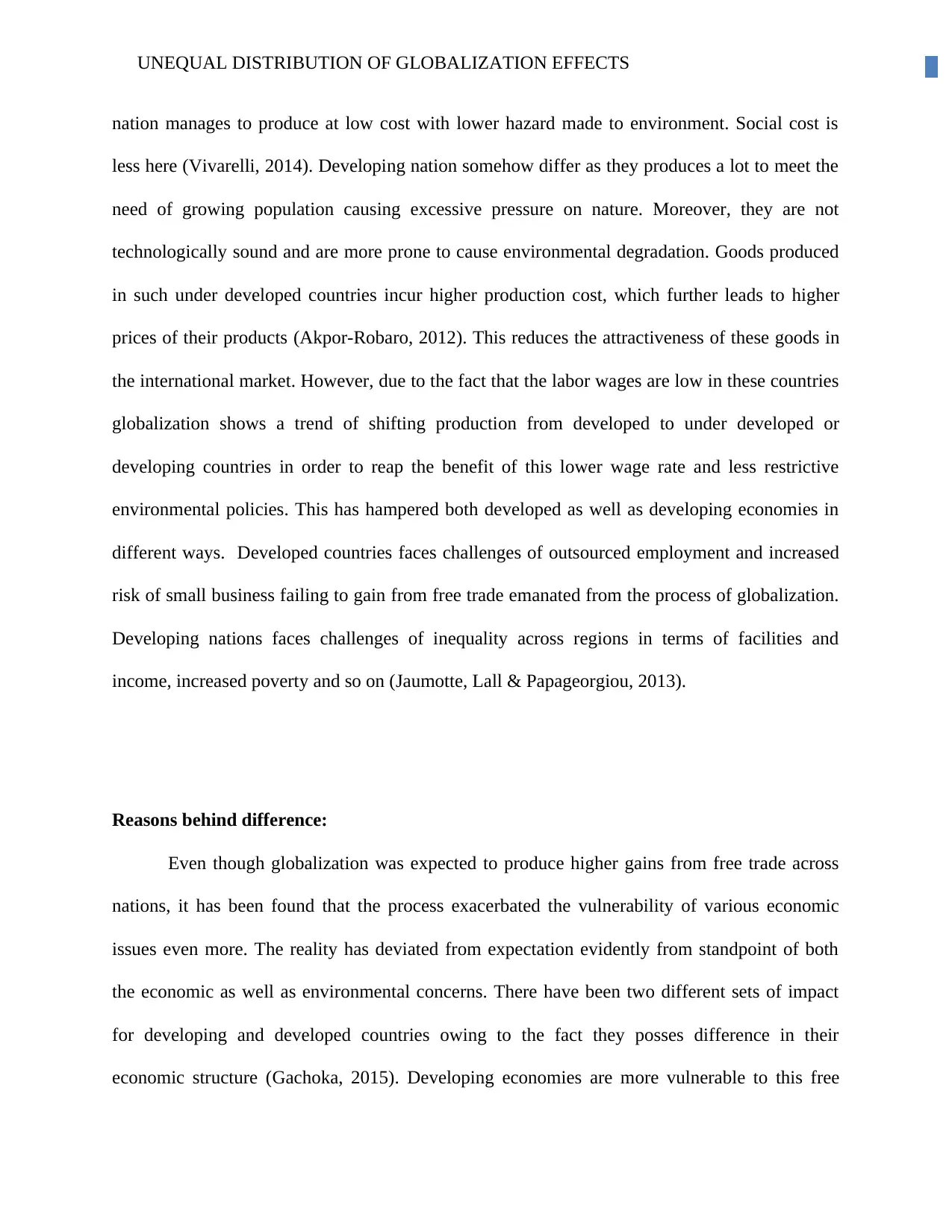
7UNEQUAL DISTRIBUTION OF GLOBALIZATION EFFECTS
nation manages to produce at low cost with lower hazard made to environment. Social cost is
less here (Vivarelli, 2014). Developing nation somehow differ as they produces a lot to meet the
need of growing population causing excessive pressure on nature. Moreover, they are not
technologically sound and are more prone to cause environmental degradation. Goods produced
in such under developed countries incur higher production cost, which further leads to higher
prices of their products (Akpor-Robaro, 2012). This reduces the attractiveness of these goods in
the international market. However, due to the fact that the labor wages are low in these countries
globalization shows a trend of shifting production from developed to under developed or
developing countries in order to reap the benefit of this lower wage rate and less restrictive
environmental policies. This has hampered both developed as well as developing economies in
different ways. Developed countries faces challenges of outsourced employment and increased
risk of small business failing to gain from free trade emanated from the process of globalization.
Developing nations faces challenges of inequality across regions in terms of facilities and
income, increased poverty and so on (Jaumotte, Lall & Papageorgiou, 2013).
Reasons behind difference:
Even though globalization was expected to produce higher gains from free trade across
nations, it has been found that the process exacerbated the vulnerability of various economic
issues even more. The reality has deviated from expectation evidently from standpoint of both
the economic as well as environmental concerns. There have been two different sets of impact
for developing and developed countries owing to the fact they posses difference in their
economic structure (Gachoka, 2015). Developing economies are more vulnerable to this free
nation manages to produce at low cost with lower hazard made to environment. Social cost is
less here (Vivarelli, 2014). Developing nation somehow differ as they produces a lot to meet the
need of growing population causing excessive pressure on nature. Moreover, they are not
technologically sound and are more prone to cause environmental degradation. Goods produced
in such under developed countries incur higher production cost, which further leads to higher
prices of their products (Akpor-Robaro, 2012). This reduces the attractiveness of these goods in
the international market. However, due to the fact that the labor wages are low in these countries
globalization shows a trend of shifting production from developed to under developed or
developing countries in order to reap the benefit of this lower wage rate and less restrictive
environmental policies. This has hampered both developed as well as developing economies in
different ways. Developed countries faces challenges of outsourced employment and increased
risk of small business failing to gain from free trade emanated from the process of globalization.
Developing nations faces challenges of inequality across regions in terms of facilities and
income, increased poverty and so on (Jaumotte, Lall & Papageorgiou, 2013).
Reasons behind difference:
Even though globalization was expected to produce higher gains from free trade across
nations, it has been found that the process exacerbated the vulnerability of various economic
issues even more. The reality has deviated from expectation evidently from standpoint of both
the economic as well as environmental concerns. There have been two different sets of impact
for developing and developed countries owing to the fact they posses difference in their
economic structure (Gachoka, 2015). Developing economies are more vulnerable to this free
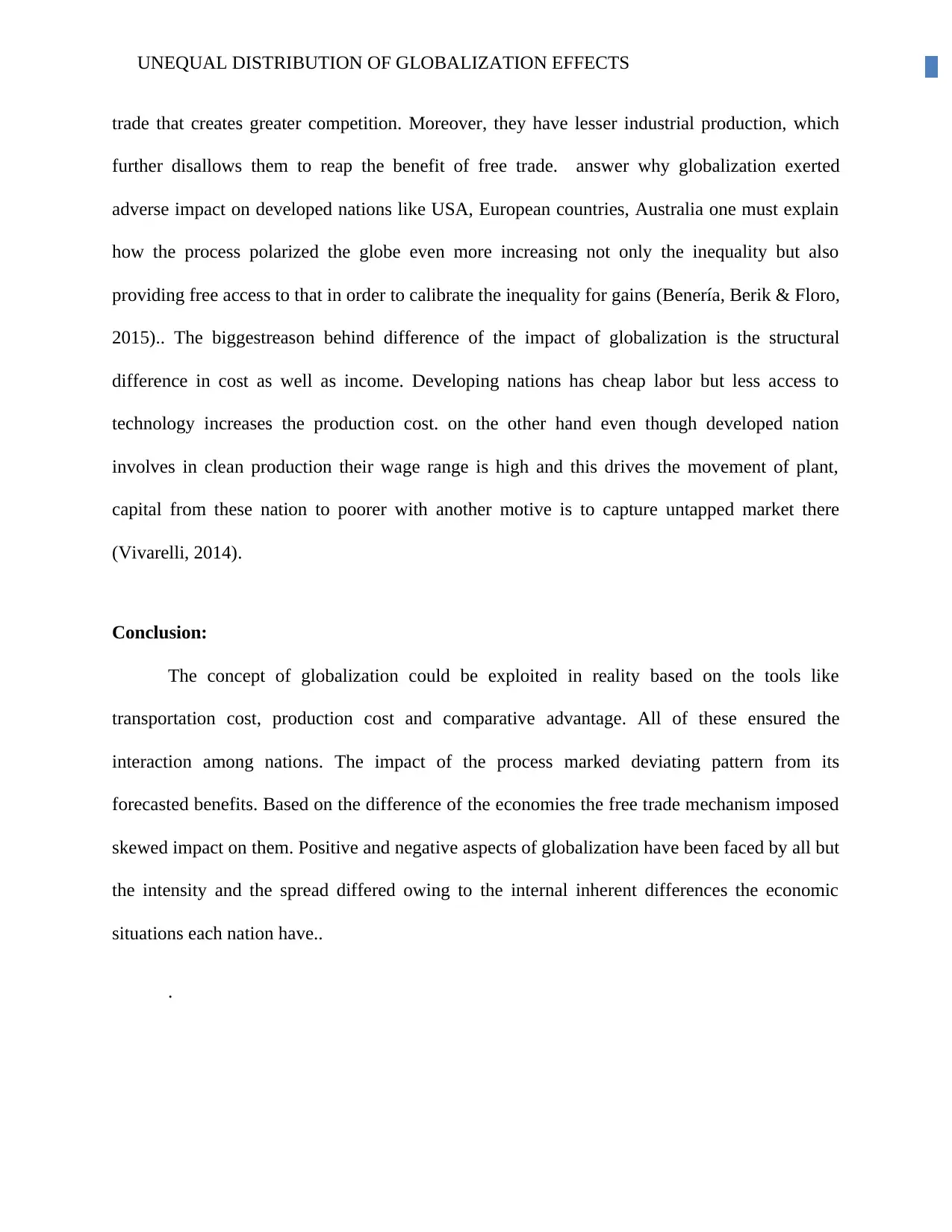
8UNEQUAL DISTRIBUTION OF GLOBALIZATION EFFECTS
trade that creates greater competition. Moreover, they have lesser industrial production, which
further disallows them to reap the benefit of free trade. answer why globalization exerted
adverse impact on developed nations like USA, European countries, Australia one must explain
how the process polarized the globe even more increasing not only the inequality but also
providing free access to that in order to calibrate the inequality for gains (Benería, Berik & Floro,
2015).. The biggestreason behind difference of the impact of globalization is the structural
difference in cost as well as income. Developing nations has cheap labor but less access to
technology increases the production cost. on the other hand even though developed nation
involves in clean production their wage range is high and this drives the movement of plant,
capital from these nation to poorer with another motive is to capture untapped market there
(Vivarelli, 2014).
Conclusion:
The concept of globalization could be exploited in reality based on the tools like
transportation cost, production cost and comparative advantage. All of these ensured the
interaction among nations. The impact of the process marked deviating pattern from its
forecasted benefits. Based on the difference of the economies the free trade mechanism imposed
skewed impact on them. Positive and negative aspects of globalization have been faced by all but
the intensity and the spread differed owing to the internal inherent differences the economic
situations each nation have..
.
trade that creates greater competition. Moreover, they have lesser industrial production, which
further disallows them to reap the benefit of free trade. answer why globalization exerted
adverse impact on developed nations like USA, European countries, Australia one must explain
how the process polarized the globe even more increasing not only the inequality but also
providing free access to that in order to calibrate the inequality for gains (Benería, Berik & Floro,
2015).. The biggestreason behind difference of the impact of globalization is the structural
difference in cost as well as income. Developing nations has cheap labor but less access to
technology increases the production cost. on the other hand even though developed nation
involves in clean production their wage range is high and this drives the movement of plant,
capital from these nation to poorer with another motive is to capture untapped market there
(Vivarelli, 2014).
Conclusion:
The concept of globalization could be exploited in reality based on the tools like
transportation cost, production cost and comparative advantage. All of these ensured the
interaction among nations. The impact of the process marked deviating pattern from its
forecasted benefits. Based on the difference of the economies the free trade mechanism imposed
skewed impact on them. Positive and negative aspects of globalization have been faced by all but
the intensity and the spread differed owing to the internal inherent differences the economic
situations each nation have..
.
⊘ This is a preview!⊘
Do you want full access?
Subscribe today to unlock all pages.

Trusted by 1+ million students worldwide
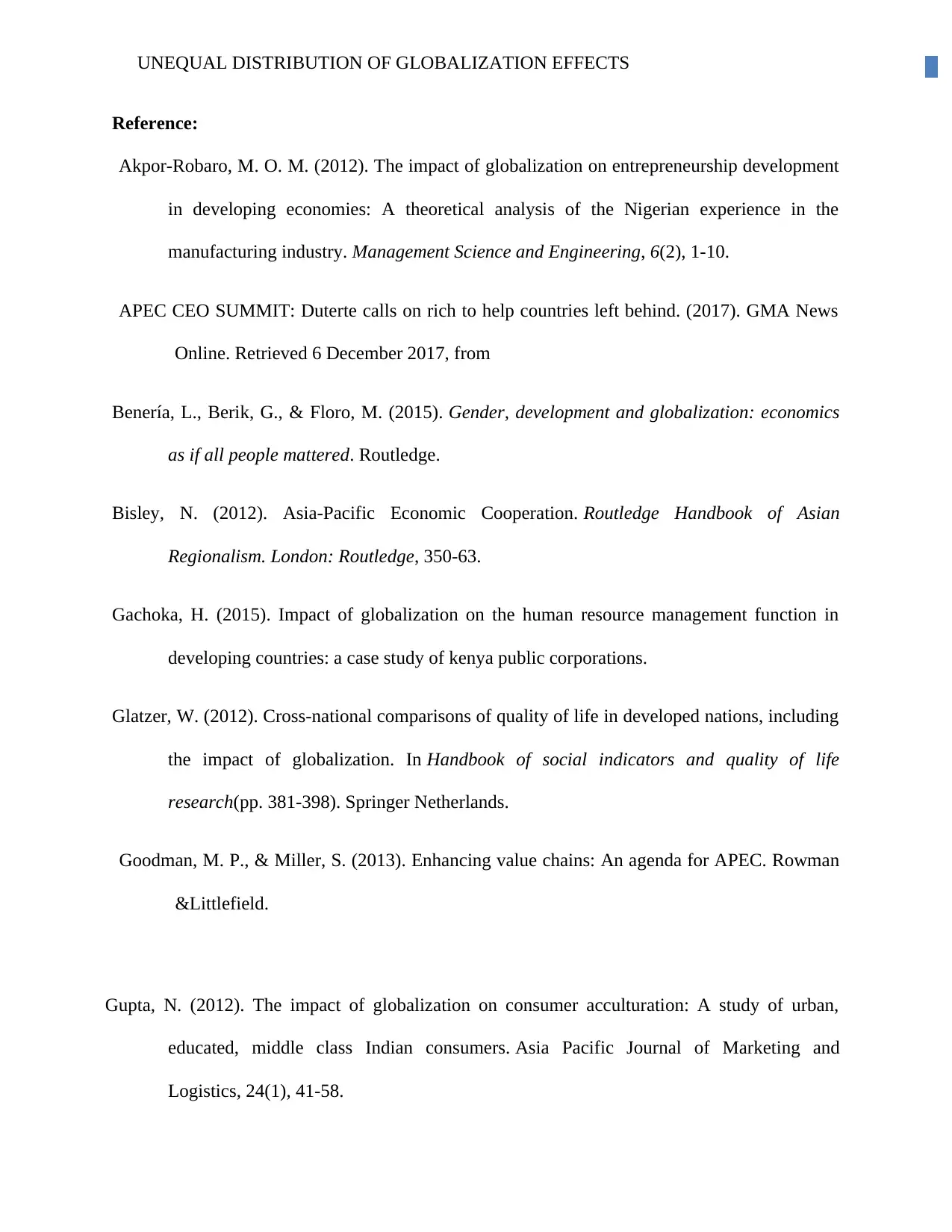
9UNEQUAL DISTRIBUTION OF GLOBALIZATION EFFECTS
Reference:
Akpor-Robaro, M. O. M. (2012). The impact of globalization on entrepreneurship development
in developing economies: A theoretical analysis of the Nigerian experience in the
manufacturing industry. Management Science and Engineering, 6(2), 1-10.
APEC CEO SUMMIT: Duterte calls on rich to help countries left behind. (2017). GMA News
Online. Retrieved 6 December 2017, from
Benería, L., Berik, G., & Floro, M. (2015). Gender, development and globalization: economics
as if all people mattered. Routledge.
Bisley, N. (2012). Asia-Pacific Economic Cooperation. Routledge Handbook of Asian
Regionalism. London: Routledge, 350-63.
Gachoka, H. (2015). Impact of globalization on the human resource management function in
developing countries: a case study of kenya public corporations.
Glatzer, W. (2012). Cross-national comparisons of quality of life in developed nations, including
the impact of globalization. In Handbook of social indicators and quality of life
research(pp. 381-398). Springer Netherlands.
Goodman, M. P., & Miller, S. (2013). Enhancing value chains: An agenda for APEC. Rowman
&Littlefield.
Gupta, N. (2012). The impact of globalization on consumer acculturation: A study of urban,
educated, middle class Indian consumers. Asia Pacific Journal of Marketing and
Logistics, 24(1), 41-58.
Reference:
Akpor-Robaro, M. O. M. (2012). The impact of globalization on entrepreneurship development
in developing economies: A theoretical analysis of the Nigerian experience in the
manufacturing industry. Management Science and Engineering, 6(2), 1-10.
APEC CEO SUMMIT: Duterte calls on rich to help countries left behind. (2017). GMA News
Online. Retrieved 6 December 2017, from
Benería, L., Berik, G., & Floro, M. (2015). Gender, development and globalization: economics
as if all people mattered. Routledge.
Bisley, N. (2012). Asia-Pacific Economic Cooperation. Routledge Handbook of Asian
Regionalism. London: Routledge, 350-63.
Gachoka, H. (2015). Impact of globalization on the human resource management function in
developing countries: a case study of kenya public corporations.
Glatzer, W. (2012). Cross-national comparisons of quality of life in developed nations, including
the impact of globalization. In Handbook of social indicators and quality of life
research(pp. 381-398). Springer Netherlands.
Goodman, M. P., & Miller, S. (2013). Enhancing value chains: An agenda for APEC. Rowman
&Littlefield.
Gupta, N. (2012). The impact of globalization on consumer acculturation: A study of urban,
educated, middle class Indian consumers. Asia Pacific Journal of Marketing and
Logistics, 24(1), 41-58.
Paraphrase This Document
Need a fresh take? Get an instant paraphrase of this document with our AI Paraphraser
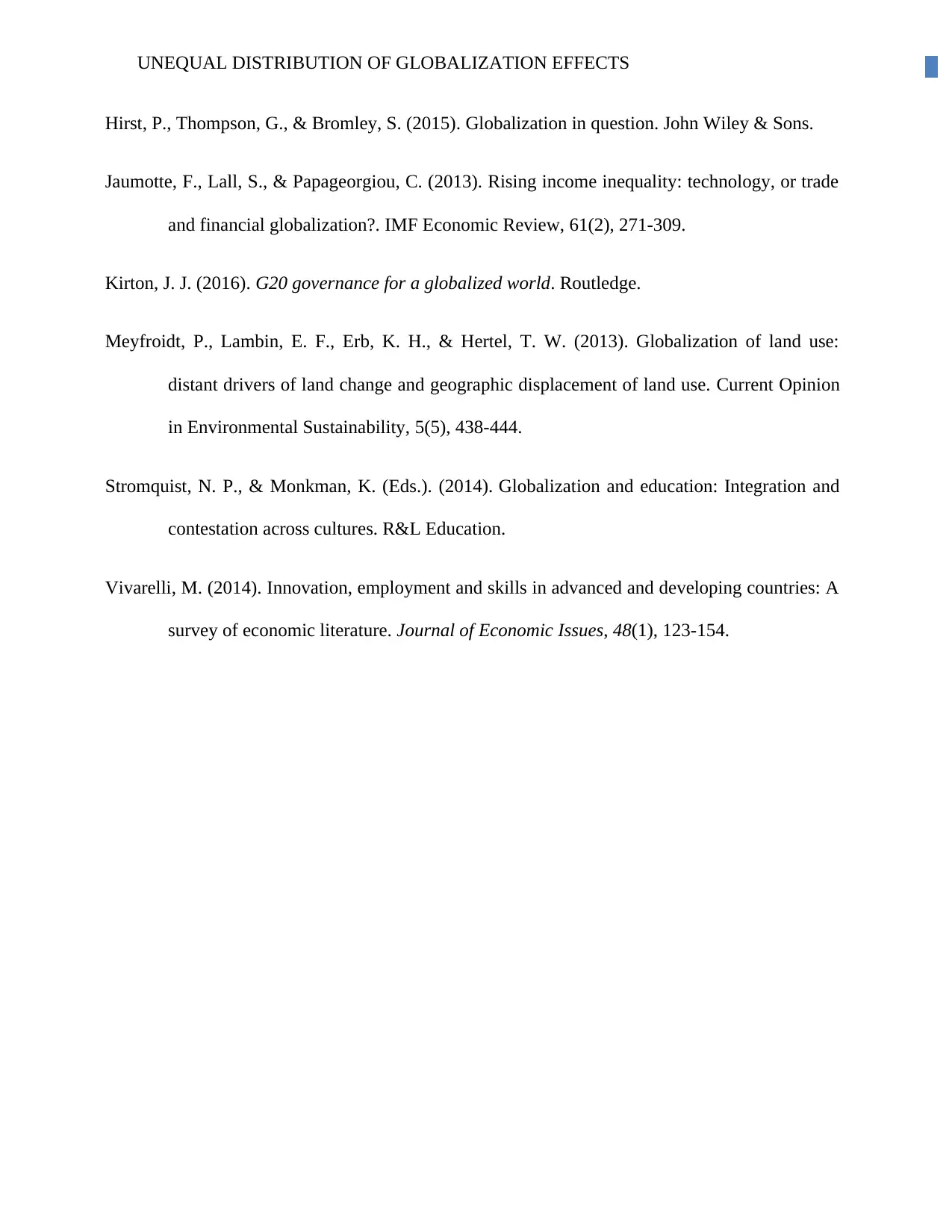
10UNEQUAL DISTRIBUTION OF GLOBALIZATION EFFECTS
Hirst, P., Thompson, G., & Bromley, S. (2015). Globalization in question. John Wiley & Sons.
Jaumotte, F., Lall, S., & Papageorgiou, C. (2013). Rising income inequality: technology, or trade
and financial globalization?. IMF Economic Review, 61(2), 271-309.
Kirton, J. J. (2016). G20 governance for a globalized world. Routledge.
Meyfroidt, P., Lambin, E. F., Erb, K. H., & Hertel, T. W. (2013). Globalization of land use:
distant drivers of land change and geographic displacement of land use. Current Opinion
in Environmental Sustainability, 5(5), 438-444.
Stromquist, N. P., & Monkman, K. (Eds.). (2014). Globalization and education: Integration and
contestation across cultures. R&L Education.
Vivarelli, M. (2014). Innovation, employment and skills in advanced and developing countries: A
survey of economic literature. Journal of Economic Issues, 48(1), 123-154.
Hirst, P., Thompson, G., & Bromley, S. (2015). Globalization in question. John Wiley & Sons.
Jaumotte, F., Lall, S., & Papageorgiou, C. (2013). Rising income inequality: technology, or trade
and financial globalization?. IMF Economic Review, 61(2), 271-309.
Kirton, J. J. (2016). G20 governance for a globalized world. Routledge.
Meyfroidt, P., Lambin, E. F., Erb, K. H., & Hertel, T. W. (2013). Globalization of land use:
distant drivers of land change and geographic displacement of land use. Current Opinion
in Environmental Sustainability, 5(5), 438-444.
Stromquist, N. P., & Monkman, K. (Eds.). (2014). Globalization and education: Integration and
contestation across cultures. R&L Education.
Vivarelli, M. (2014). Innovation, employment and skills in advanced and developing countries: A
survey of economic literature. Journal of Economic Issues, 48(1), 123-154.
1 out of 11
Related Documents
Your All-in-One AI-Powered Toolkit for Academic Success.
+13062052269
info@desklib.com
Available 24*7 on WhatsApp / Email
![[object Object]](/_next/static/media/star-bottom.7253800d.svg)
Unlock your academic potential
Copyright © 2020–2025 A2Z Services. All Rights Reserved. Developed and managed by ZUCOL.





